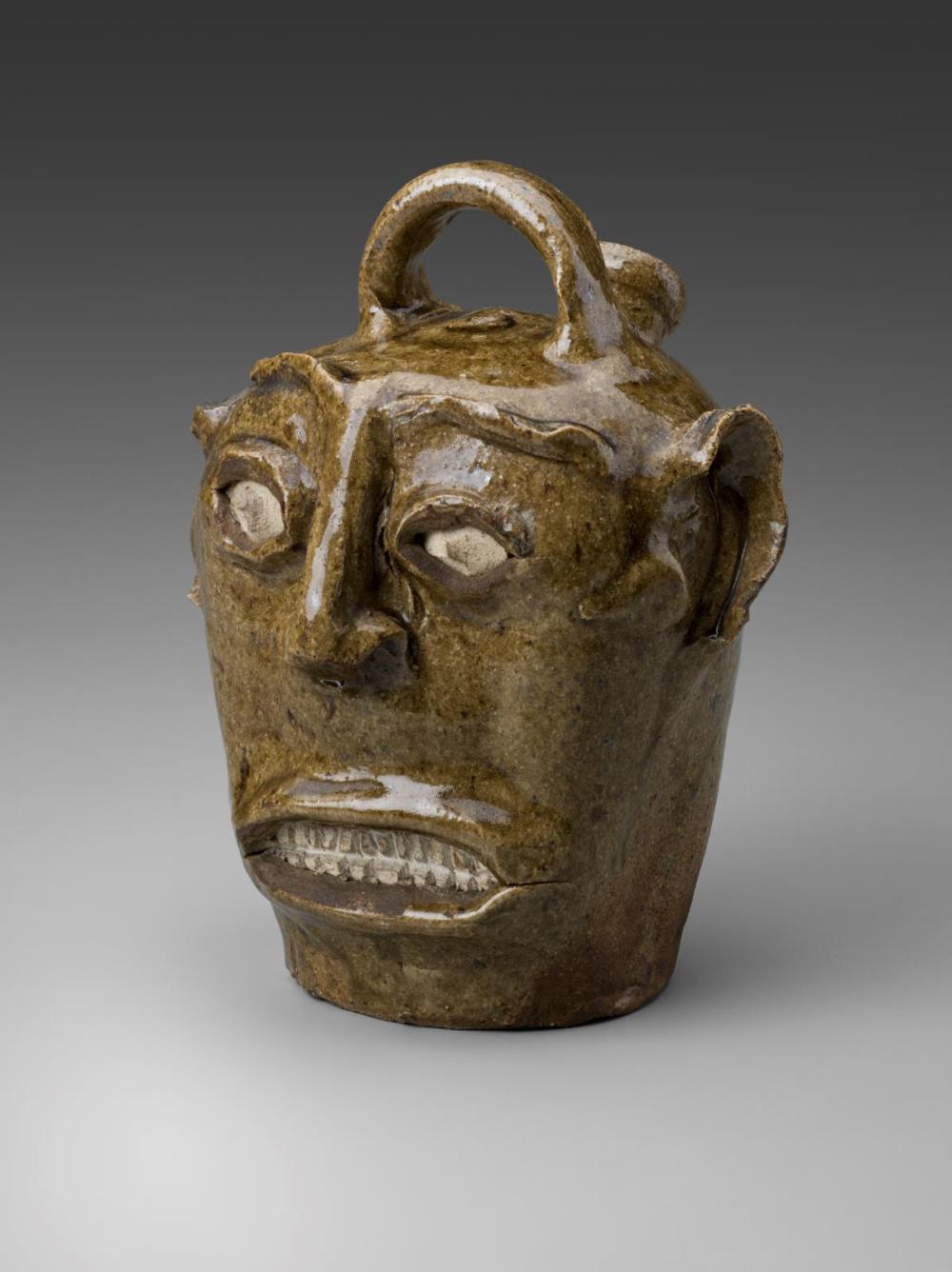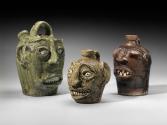Advanced Search
Face jug
about 1860
Object Place: Edgefield District, South Carolina
Medium/Technique
Stoneware, alkaline (ash) glaze; kaolin clay inserts
Dimensions
Overall: 21.6 x 17.8 x 18.4 cm (8 1/2 x 7 x 7 1/4 in.)
Credit Line
The John Axelrod Collection—Frank B. Bemis Fund, Charles H. Bayley Fund, and The Heritage Fund for a Diverse Collection
Accession Number2011.1807
OUT ON LOAN
On display at High Museum of Art, Atlanta, GA, February 16, 2024 – May 12, 2024
On display at High Museum of Art, Atlanta, GA, February 16, 2024 – May 12, 2024
CollectionsAmericas
Although made in the Edgefield district of South Carolina by enslaved potters who produced functional stoneware jars sold primarily to whites, these jugs were not commercial products. They are exceptionally rare examples of objects made by slaves for their own community and directly link West African practices with African American slaves. As early as 1862, they were known to be made by slaves "for their own purposes," according to a plantation and pottery owner, Colonel Thomas Davies. Scholars now believe that those uses were spiritual rather than practical.
Face jugs were much smaller that the utilitarian vessels made for storing gallons of preserved meats, pickled vegetables, and other foodstuffs for large plantation communities. Instead, these vessels, typically just four to eight inches high, are distinguished by their sculptural facial features, including pronounced brows, nose, lips, and ears. Although their clay bodies are alkaline-glazed stoneware like the Edgefield commercial wares, their eyes and teeth are made of unglazed white kaolin clay--a feature that required technical skill and extra labor, since kaolin shrinks more than the body clay during firing. Kaolin is an important material in ritual practices in many African cultures, particularly in nkisi figures used in Kongo cultures to channel and contain spiritual powers.
The use of kaolin in face vessels demonstrates a direct and specific connection between west-central Africa and Edgefield: slaves from Kongo were imported to Edgefield just before the earliest slave-made vessels were produced there in the early 1860s. In 1858, an illegal slave ship, the Wanderer, docked a Jekyll Island, Georgia. Of the 407 Africans aboard--most from Kongo societies--over 100 were sent to Edgefield, where many were put to work in the potteries. At least one of these, called Romeo Thomas, is known to have worked in Thomas Davies's pottery. Significant research and oral history indicate that slaves in the region used face jugs covertly in African religious activities such as conjure, root magic, charms, and spells--practices that helped slaves re-create and maintain African belief systems in America.
This text was adapted from Lowery Stokes Sims et al., Common Wealth: Art by African Americans in the Museum of Fine Arts, Boston (Boston: MFA Publications, 2015).
Face jugs were much smaller that the utilitarian vessels made for storing gallons of preserved meats, pickled vegetables, and other foodstuffs for large plantation communities. Instead, these vessels, typically just four to eight inches high, are distinguished by their sculptural facial features, including pronounced brows, nose, lips, and ears. Although their clay bodies are alkaline-glazed stoneware like the Edgefield commercial wares, their eyes and teeth are made of unglazed white kaolin clay--a feature that required technical skill and extra labor, since kaolin shrinks more than the body clay during firing. Kaolin is an important material in ritual practices in many African cultures, particularly in nkisi figures used in Kongo cultures to channel and contain spiritual powers.
The use of kaolin in face vessels demonstrates a direct and specific connection between west-central Africa and Edgefield: slaves from Kongo were imported to Edgefield just before the earliest slave-made vessels were produced there in the early 1860s. In 1858, an illegal slave ship, the Wanderer, docked a Jekyll Island, Georgia. Of the 407 Africans aboard--most from Kongo societies--over 100 were sent to Edgefield, where many were put to work in the potteries. At least one of these, called Romeo Thomas, is known to have worked in Thomas Davies's pottery. Significant research and oral history indicate that slaves in the region used face jugs covertly in African religious activities such as conjure, root magic, charms, and spells--practices that helped slaves re-create and maintain African belief systems in America.
This text was adapted from Lowery Stokes Sims et al., Common Wealth: Art by African Americans in the Museum of Fine Arts, Boston (Boston: MFA Publications, 2015).
DescriptionFace vessel with handle at top and spout at rear. Eyes and teeth made from unglazed white kaolin set in greenish-glazed earthenware body. Proper right ear has an old loss at the top.
ProvenanceAbout 1997, sold by Tony L. Shank, Marion, SC to John Axelrod, Boston; 2011, sold by John Axelrod to the MFA. (Accession Date: June 22, 2011)



